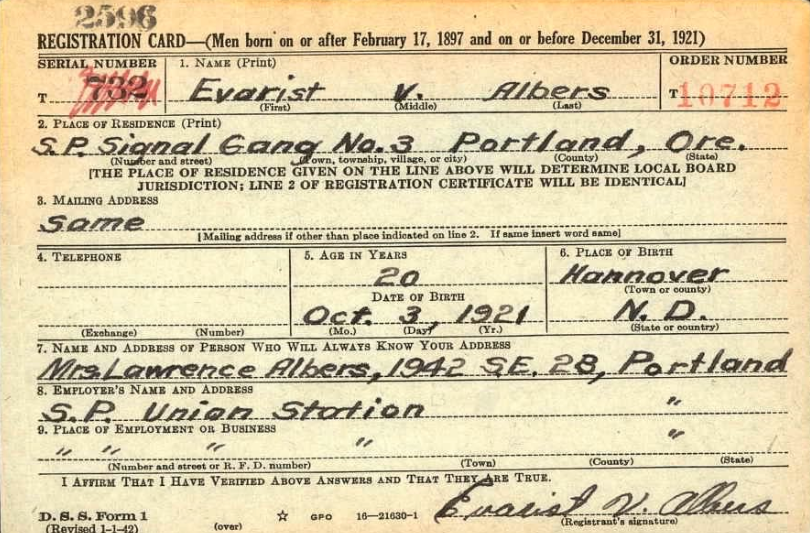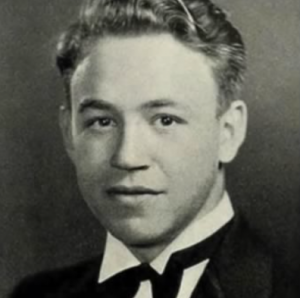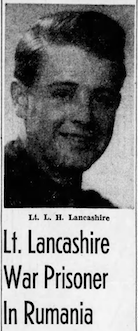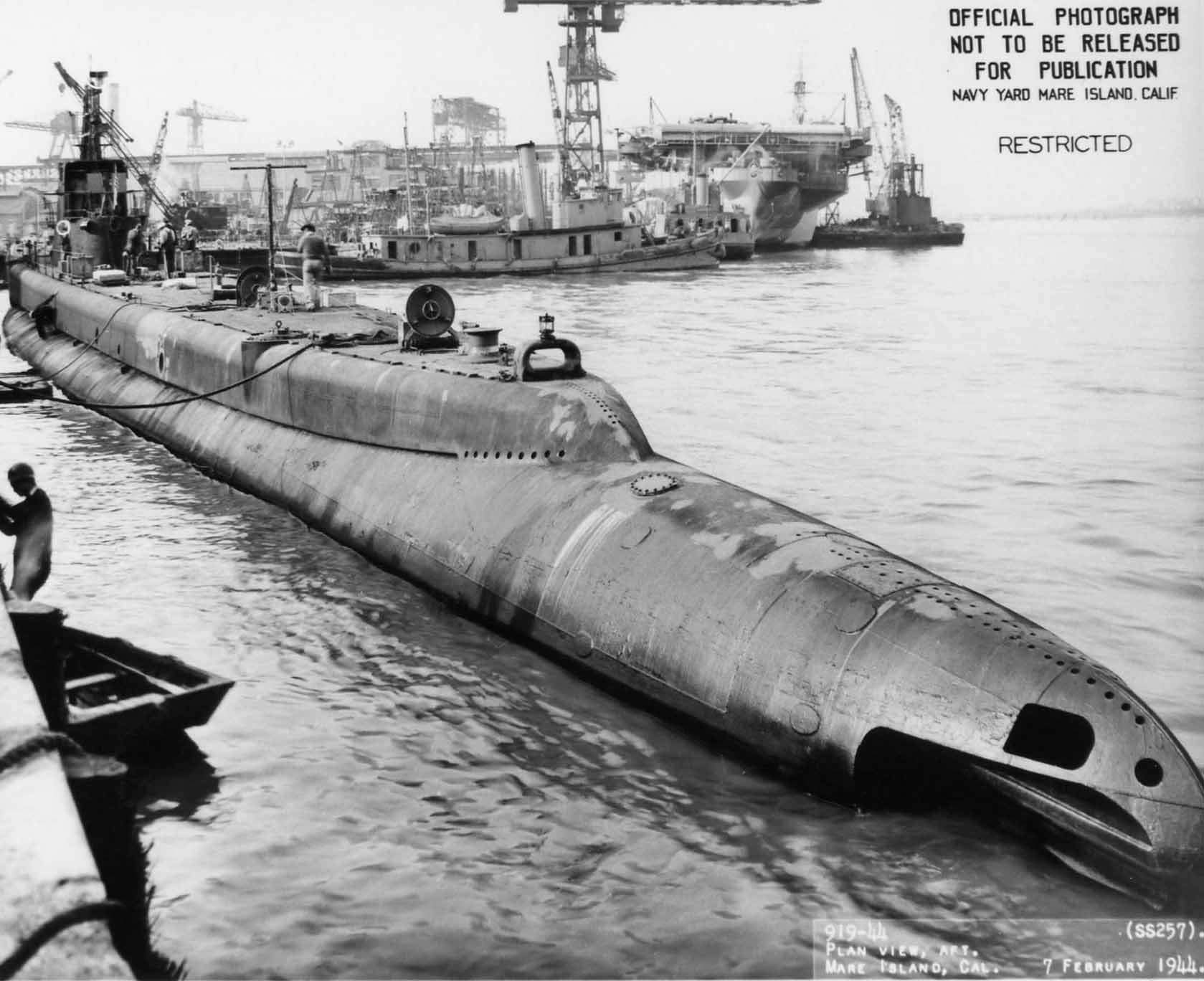During WWII, the United States Army adopted a form to document the fate of missing air crews. Missing Air Crew Reports (MACRs) are a valuable resource that provides details, witness statements, survivor accounts, and more. The reports tell the story of aircraft that went down for various reasons, including enemy fire, bad weather, or mechanical difficulties.
A glance through the MACR collection reveals a rich collection of stories of bravery, sacrifice, and survival. Army rules dictated that a MACR be filed within 48 hours after an aircraft was officially reported as missing. While this allowed for fresh witness testimony, it also meant that the outcome for some crew members was unknown. The reports include each soldier’s military ID number. This information allows researchers to explore additional records such as the POW collection, hospital admissions, or death records.
Here are a few stories from the MACR Collection:
On November 1, 1943, S/Sgt. Evarist V. Albers and his crew from the 47th Bomb Squadron, 97th Bomb Group, took off for a bombing mission over Italy. As they neared their target, the formation encountered enemy flak. Moments later, the aircraft lurched. They had been hit and were going down! An explosion took a wing off and burned Albers’s face. They began to roll, but Albers managed to bail out. He searched for other survivors as he floated to the ground but didn’t see any other sign of life. A nearby gunner testified that he saw two chutes, one fully opened, but the other one was trailing. Albers was the only survivor of the crash and returned to service four days later.
On August 7, 1942, a B-26 Marauder loaded with seven crew and Associated Press reporter Vernon Haugland encountered a severe storm and drifted off-course over New Guinea. With fuel running low, the crew bailed out at 13,000 feet and landed in the jungle. The crew became separated and spent the next several weeks trying to escape. Haugland kept a journal of his 43 days in the wilderness. He nearly starved to death and weighed just 95 pounds when he was rescued. Haugland became the first civilian recipient of the Silver Star medal for heroism. He later published a book, Letter from New Guinea, about his experiences. Co-pilot James A. Michael and 1st. Lt. Carroll W. Casteel did not survive the ordeal. Pilot Duncan A. Seffern spent two weeks in the jungle before being rescued but died months later in another airplane crash.
Lawrence H. Lancashire served in the 93rd Bomb Group, 409th Bomb Squad, and participated in Operation Tidal Wave – the bombing of oil refineries around Ploiesti, Romania, in 1943. Lancashire was co-piloting a B-24 Bomber with a crew of 10. They were flying at tree-top level when enemy fire hit the aircraft’s engines, and they crash-landed. Lancashire was captured and spent three months as a prisoner of war. Others in the crew were not so lucky. Pilot Hubert H. Womble lost a foot and was also taken POW. William K. Little broke his leg and was trapped in the plane. While waiting hours for extrication, airplane fuel ran over his body. He died eight days later from untreated injuries and the poisoning effects of gasoline vapor. Details about other crew members are also contained in the report.
If you want to be inspired by more incredible stories of heroism, explore the Missing Air Crew Reports collection today on Fold3®.








All these guys went thru untold bravery! God Bless!
My Mom’s brother, Francis “Jim” Houston III, is one of the MACR records. On 19 March 1945, on what was to be his last flight, his plane was shot down on a bombing mission over Magdeburg, Germany. He didn’t make it home-he was 19 years old.
Thank you to all the men who served to make the world a better place.
Heartbreaking, and that is most of war. We could never do enough to honor our soldiers.
Our mothers never got over the loss of their beloved brothers , our uncles, so young , who never came home again. My uncle was killed near Normandy..
No.
These reports are full of information. The two I have in my possession even list personal belongings as well as contain personal communications from family members to the military about their missing loved ones. The reports I have are for Lt. Bruce H. Brown who was lost over Tosny, France. His remains were comingled with other crew members. They have recently been exhumed from the American Cemetery at Normandy and are awaiting at Oltorff AFB Nebraska for DNA testing to aid in identification. My other cousin, Sgt. Francis Pershing McNamara, was a crew member on the Green Hornet that crashed at see near the Palmyra Atoll in the Line Islands. He lived for 33 days aboard a raft along with two other crew members – The Unbroken tells his story.
Thanks for sharing those histories. So much sacrifice and tragedy. We need to keep those experiences alive for posterity. You have likely read “The Raft” by Robert Trumbull..If not, may I recommend?
My mother’s cousin Harry Hutchinson was in the Air Force in the Pacific. The plane went down as the were ferrying officers to another island in the South Pacific. I have searched in vain but it appears no wreckage was ever found. I feel as if I’ve come to a dead end.
Contact the Defense POW/MIA Accounting Agency (DPAA). They have a file containing all the know information on him.
The only information I have on my cousin, Clair Carl of Reinerton, Pennsylvanis, is from word of mouth from my father who got informantion from Clair’s mother, his older sister. He was a tail gunner and was shot down, and after the war my aunt had the remains from a cemetery sent home to Pennsylvania. My father said there was no way to verify the remains but it made his sister feel better about the death, at a cost she could not really afford. Can I research this oral history to verify the facts from my cousin? Everyone else in the family is deceased.
This is moving and quite awesome. No personal connection to ww2 except for what we all strive to have. I count myself lucky, however, to be given a own into history.
George Bailey’s plane was reported missing during WW ll in the Aleutian Islands about 1942. I don’t know if he was part of the crew or a passenger.
My father, Captain Lowell F. Van Gerpen, was the officer in charge of a search done on 26 Apr 1945 for a missing plane, Dakota No. 809 of 12 Combat Cargo Sqn USAAF. The crew consisted of the pilot, copilot, radio operator, aerial engineer, and three kickers. The kickers were to push out cargo when the location was reached. The mission was to drop food to troops fighting in Burma. They took off at 0600 25 Apr 1945 from Tulihal Airstrip, Imphal, India. At 0955, they were hit by a Japanese shell and crashed into a hill; the plane burned. One of the kickers was thrown from the plane and survived. After wandering in the bush for 11 days, he saw some Indian troops and was taken to a hospital. The search was made from Tulihal as far as Mandalay. No other crew members were found.
This must be a wonderful resource. I wonder if anyone has yet located
similar reports relating to U.S.A. pilots who were killed in Australia during WW2,
whose death place was known. Apparently, all WW2 5th squadron USAAF
records of service in Australia are missing. Australia’s own “Oz at War”/
“Australia at War” datbase is superb, but some records cannot be located.
My dad, A1C, Franklin Bolac, was a tail gunner who flew off the USS Hornet during the Battle of Midway. As I understand it, that Hornet was a replacement for the Hornet that sank earlier.
He was so proud of the Hornet and it’s crew. For part of his time he flew with Pilot Harold Buell. Buell authored a book entitled “Dauntless Helldivers”. I didn’t know about the book until sometime in the 1990’s when I happened to be browsing the Bookstore at Arlington National Cemetery. The “Dauntless Helldiver” sounded familiar. I was so surprised to find my Dad’s name in the Index and some sentences about him in the text. He remained in contact with some of his shipmates, met them at Hornet Reunions and other places. They remained friends for the rest of their lives. His archive has been donated to the USS Hornet Museum.
I sent in a request for my dead brothers DD-214 over 2 years ago, PLEASE SOMEONE RESPOND
Contact your Congressman’s office and ask for assistance.
I searched without any luck for a pilot named “Mc___.” I eventually found the record by searching for the date of the record and learned that the Army Air Force typed in the crew name records as “McSPACE___.”
Anyone with a missing relative should contact the Defense POW/MIA Accounting Agency (DPAA). They have a file containing all the know information on him if he served in WWII to the present. Simply do a google search for DPAA. I worked for DPAA and its predecessor agencies for 25 years until I retired last September.
My Uncle Delmar Dotson went down in New Guinea with his crew of (7?).
The plane and crew were lost in those mountains for over 50 years before a recovery was made. He was with the Army Air Force.
I found reports written by my Grandfather, a Lieutenant in the Army Air Corps
My adopted father was shot down as he flew over the French coast by “friendly fire”. While in formation the plane behind him was clearing and testing their guns, which was operating procedure. They accidentally shot my father’s plane down behind enemy lines. He was taken in by the French Underground and hidden from the Germans until he could get back. It was my understanding that during that time he helped the Underground at night, helping to disrupt the Germans forward movement by assisting in blowing up bridges etc. He had nothing but praise for his French assistance. They fed him like a king and kept him safe. My understanding is that all his crewmates survived the plane being shot down. As soon as he returned home he married my mother and his crewmembers stood up with him as he married my mother. My thanks to the French people who were brave enough to make him safe and welcomed him into their families and lives!
What a great story – thanks for sharing it.
On March 22, 1944, my uncle’s (Keith Truman Holm, navigator) B-24 crashed into Mt Thumb in New Guinea. His plane, #42-41081 (named Weezie) was found 38 years later in April of 1982 and the story of the 22 men on board and finding of the plane to identifying the remains is detailed in the book A Missing Plane written by Susan Sheehan. My thanks to Bruce Hoy and his team who made it their mission to locate 350 missing planes from the US and Australia.
I’m not aware if this event is recorded in the excellent database “Australia at War” published in Brisbane, Australia by Peter Dunne but it’s worth a google search using the words “Australia at War”, “Holm” and “peter Dunne”, as Peter has recorded the details of so many crashes in New Guinea as well as Australia. Don’t forget to include the quotation marks as above if you search google and/or google books.
.
My Uncle, Robert E. McCarthy was not on a plane, but on a ship as a Marine. He was killed on Tarawa, the first wave, only 19 years old, and the last of the McCarthy males, my Mother and Robert were for four days the same age, and my Mother was devastated to lose her only sibling.
I have a buddy who’s uncle was also KIA in the first wave on Tarawa. Name was Sgt. James Hubert. An outfit called History Flight conducted a recovery effort a few years ago after an unknown Marine gravesite was discovered during a construction project on the island. If you do not know if Robert’s remains have been recovered, you could check with History Flight.
https://historyflight.com/tarawa/
Does this only apply to US planes/personnel? I have Scottish relatives who flew gliders in WW2 and were shot down over Belgium.
Thanks
MACRs are an American/US documention process. Other countries probably had similar programs but you would have to check with the specifc country.
Thank you for the information. Very helpful.
The MACRs are a great resource. I first laid hands the MACR for my grandfather 1st Lt. Loren E. Hintz in the mid-1990’s. Hintz was a P-47 Fighter pilot 79th FG, 86th FS based in Cesenatico, Italy and KIA on 21 April 1945 (same day Bologna was liberated). My grandma got an MIA telgram on the Eve of VE Day. That MACR served a the catalyst for a subsequent 20 year research project I conducted. I also obtained Loren’s Inidvidual Deceased Personnel file (IDPF) in 2014 that yielded additional information . I teamed with an amazing group of Italian volunteers in 2016 after identifying the suspected crash site. We excavated the site, recovered the P-47 wreckage as well as both of Loren’s dog tags and his mortal remains. Three generations of Lt. Hintz’s family were on hand in Italy for the recovery including both of his children, grandchildren and greatgrand children all of whom never knew him. #findingloren
A wonderful story.
My wife’s uncle was in the USAAF was involved in a collision over the gulf of Mexico about 1943 with another B 17 while on a training exercise.
my father-in-law was a navy pilot in WWII, flying recon. in the Pacific. He was downed in the
Pacific after scaring off an enemy plane with machine gun fire. The plane he flew was a Neptune, a large sea plane. He went down, but was able to save the crew and himself and was picked up a couple of days later by a naval destroyer.
The pilot was Richard Gavin of Minneapolis/St. Paul, MN. He was a brave and good man and great father-in-law.
I have been trying to find my husbands service record for some time now. I stopped at Eighth. Air Force museum in SC, to ask about his records. He was downed over Italy, flying a Mustang,and very badly injured, but not sure what happened after that, except to know he was sent to Douglas, Az for further recovery. Was told very bluntly I might add at the Eighth Air Force Museum that the Eighth never served in Italy. He was stationed out of England. Was never sure why he went down, but always thought it was from flack from another aircraft being shot at. In looking for his records I always get same reply, Destroyed in St Louis. If anyone can help would really appreciate it
The Veterans Service Officer in your county may have some suggestions or even your local VFW. Your US senator or US representative may be able to help as well. I do know that many records were destroyed by a fire at the Records Processing Center in St. Louis.
The National Archives Records Administration (NARA) is the first and best place to initiate your research. As a next-of-kin (NOK) relatives are entitled to the unclassified files (most personnell files from WW2 are now “unclassified”). The Library of Congress also has a trove of information. If you want to learn more, you need to perservere and work hard. Indeed many records were destroyed in the St. Louis warehouse fire in 1973, but there were often multiple copies of files stored in other locations – if you can’t find the MACR, find out what outfit he was in and get the History (basically a scan of the entire file for his outfit typically delivered to you on a DVD – this file can be thousands of pages). NARA staff can be very helpful, though they are woefully understaffed, so patientce and politeness is reccomended.
Senators or Congressman offices do not typically have the capacity or aptitude to assist – many of them don’t even know what the NARA is. Plus, if they do start start pulling rank and rattling the NARA, it can put staff in a tough position and detract from thier efforts helping people who are patiently waiting their turn to get assistance from NARA staff.
Thank you so much for your suggestions. Military research is new-ish to me and so much of the terminology is like a foreign language. I shall persevere.
My first cousin once removed served in WW2. He was a B17 pilot and was shot down by off the coast of New Guinea 2 Aug 1942.
I’ve searched the MACRs collection and Fold3 every way I can think of (variations of his name, serial number, aircraft serial number, date of crash, date declared dead), including page by page, but my cousin is not listed in the MACRs. How complete is this collection? If incomplete, will more records be added, and if so, when?
Thank you for any information you can provide
Thank you for reply to my questions. I will follow your advice to find information. All information gained here is very helpful, and important to us who do not know about the records. Blessings to all who answer these inquiries and those who served. So sorry to hear about all of the prisoners and missing. Heaven must be hearing some amazing stories.